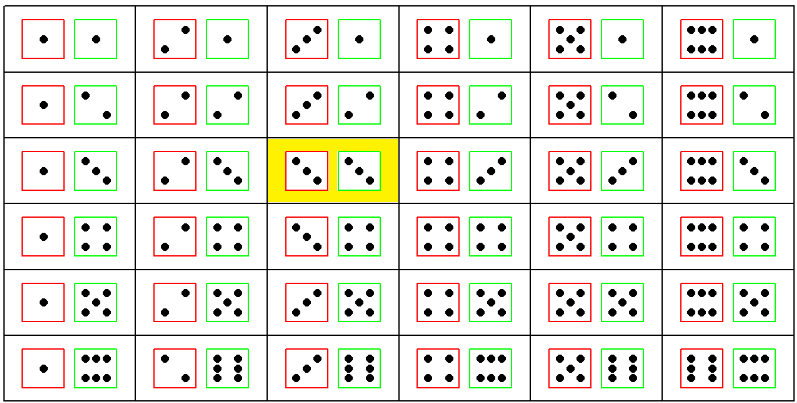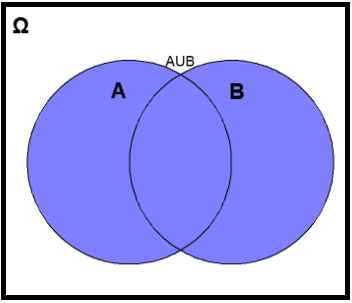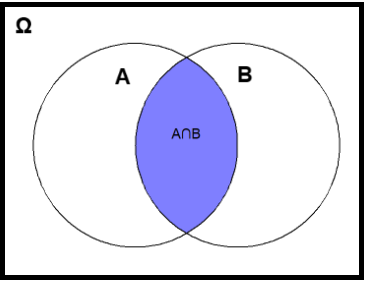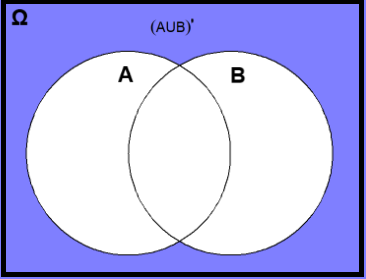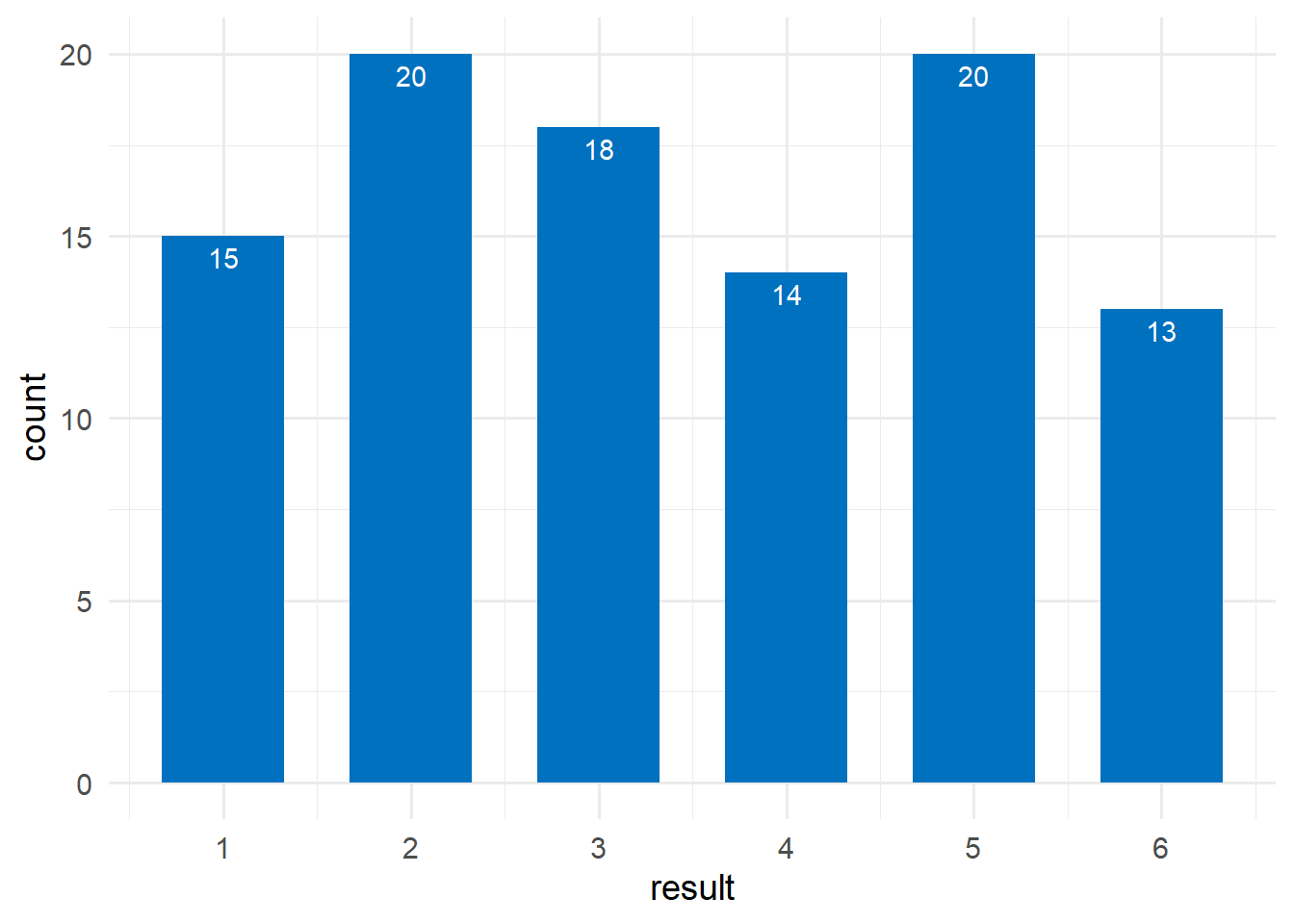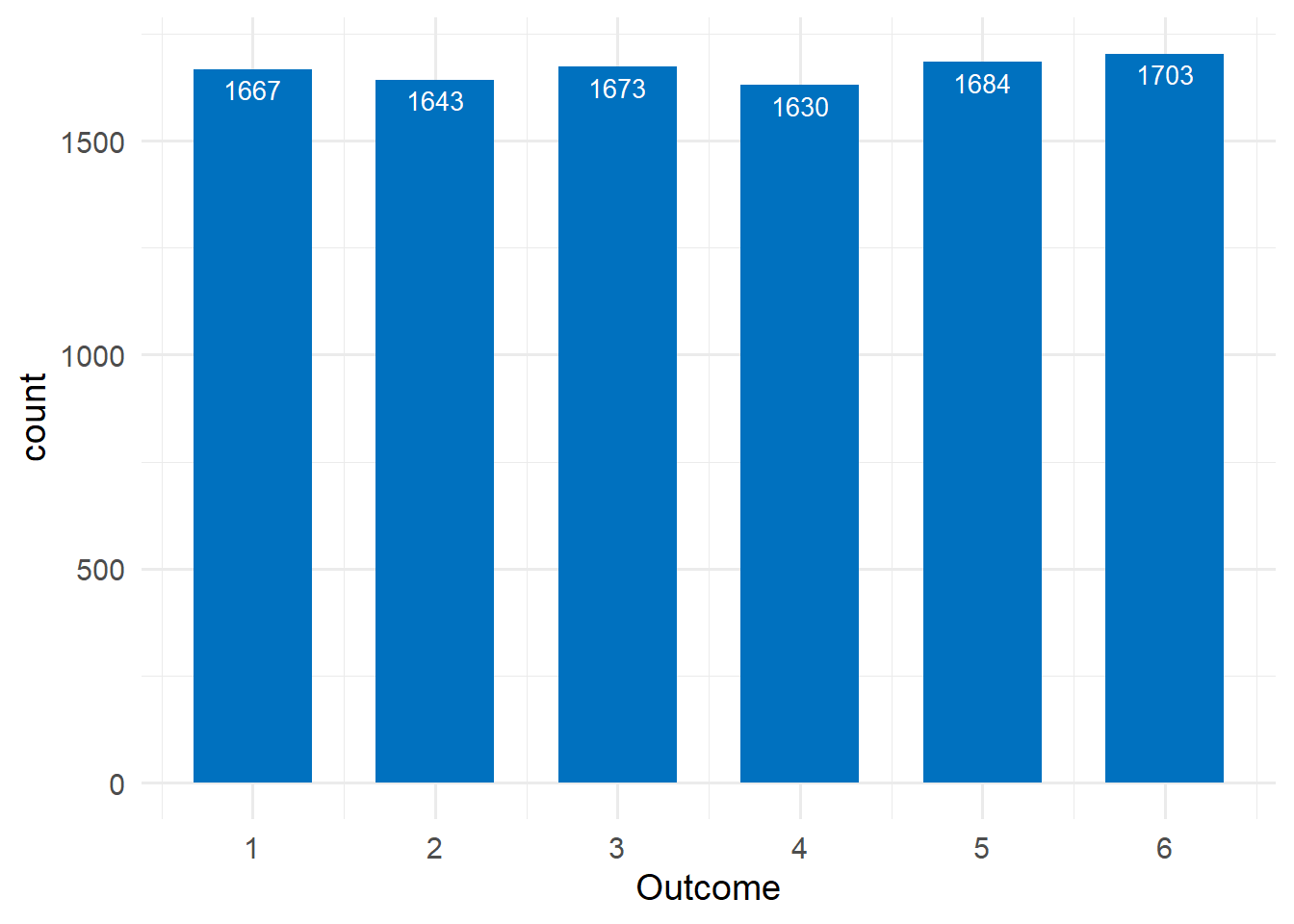13 Basic concepts of probability
The foundation of statistical inference is primarily grounded in probability theory. In this chapter, we begin by defining sample space and random events, then explore operations on events using set theory and Venn diagrams. We also cover the definitions of probability, conditional probability, and Bayes’ theorem.
13.1 Sample space and random events
Both deterministic and stochastic phenomena drive the everyday life.
A deterministic phenomenon (process or experiment) always produce the same outcome each time it is repeated under the same conditions.
A random phenomenon (process or experiment) is characterized by conditions under which the result cannot be determined with certainty before it occurs, that is, one of several possible outcomes is observed each time the process or experiment is repeated. For example, when a coin is tossed, the outcome is either heads H or tails T, but unknown before the coin is tossed.
The sample space Ω is defined as the set of all possible outcomes of a random experiment. For example, if we roll a six-sided die, the sample space is the set of the six possible outcomes, Ω ={1, 2, 3, 4, 5, 6}.

Different random experiments have different sample spaces that can be denoted in an equivalent way (flipping a coin: Ω ={H, T}, flipping two coins: Ω ={HH, HT, TH, TT}, testing for possible genotypes of a bi-allelic gene A: Ω ={AA, Aa, aa}).
A random event (henceforth called event) is denoted by a capital letter such as A, B, or C and is a sub-set of sample space Ω, including a number of possible outcomes of the experiment. For example, in the case of rolling a die, the event “even number” may be represented by A = {2, 4, 6}, which is a subset of Ω (A
If an event consists of a single outcome from the sample space, it is termed a simple event. For example, the event of getting the number 1 on rolling a die, denoted as A = {1}. If an event consists of more than a single outcome from the sample space, it is called a compound event such as rolling a die and getting an even number, A = {2, 4, 6}.
IMPORTANT
For each experiment, two events always exist:
the ample space, Ω, which comprises all possible outcomes.
the empty set =
13.2 Operations of events using set theory and Venn diagrams
13.2.1 Union of events: A
The union of the events A and B, denoted by A
Example
In the experiment of rolling a die, let’s consider the events A = “the number rolled is even” and B = “the number rolled is less than three”.
[1] 2 4 6 1
13.2.2 Intersection of events: A
The intersection of A and B, denoted by A
Example
# A = {2, 4, 6}
# B = {1, 2}
intersect(A, B)[1] 213.2.3 Complement events
As an example, consider the complement of the union of events A and B, denoted by
Example
13.2.4 Mutually exclusive events
Let’s consider the events A = “the number rolled is even” and C = “the number rolled is odd”. The events A and C are mutually exclusive (also known as incompatible or disjoint) if they cannot occur simultaneously. This means that they do not share any outcomes and
Example
The concept of probability is used in everyday life which stands for the likelihood of occurring or non-occurring of random events. The first step towards determining the probability of an event is to establish a number of basic rules that capture the meaning of probability. The probability of an event should fulfill three axioms defined by Kolmogorov:
The Kolmogorov Axioms
The probability of an event A is a non-negative number,
The probability of all possible outcomes, or sample space Ω, equals one,
If A and B are mutually exclusive (disjoint) events, meaning
13.2.5 Definitions of probability
13.2.5.1 Theoretical probability (theoretical approach)
Theoretical probability describes the behavior we expect to happen if we give a precise description of the experiment (but without conducting any experiments). Theoretically, we can list out all the equally probable outcomes of an experiment, and determine how many of them are favorable for the event A to occur. Then, the probability of an event A to occur is defined as:
Note that the Equation 13.1 only works for experiments that are considered “fair”; this means that there must be no bias involved so that all outcomes are equally likely to occur.
Example 1
What is the theoretical probability of rolling ![]() when we roll a six-sided fair die once?
when we roll a six-sided fair die once?
The theoretical probability is:
This is because only one outcome (die showing ![]() ) is favorable out of the six equally likely outcomes.
) is favorable out of the six equally likely outcomes.
Example 2
What is the probability of rolling either ![]() or
or ![]() when we roll a six-sided fair die once?
when we roll a six-sided fair die once?
The theoretical probability is:
This is because two outcomes (die showing ![]() or
or ![]() ) are favorable out of the six equally likely outcomes.
) are favorable out of the six equally likely outcomes.
We can also use the probability’s axioms. The probability of rolling a 6 is 1/6 and the probability of rolling a 5 is also 1/6. We cannot take a 5 and 6 at the same time (these events are mutually exclusive) so:
13.2.5.2 Experimental probability (frequentist approach)
The experimental probability is based on data from repetitions of the same experiment. According to this approach, the probability of an event A, denoted by P(A), is the relative frequency of occurrence of the event over a total number of experiments:
Yet, this definition seems less clear, as it does not specify the exact interpretation of “repetitions of the same experiment” (Finetti et al. 2008).
Example
We rolled a six-sided die 100 times and we recorded how often each outcome occurred (FIGURE 13.5). What is the experimental probability of getting ![]() ?
?
set.seed(348)
roll_dice(times = 100) |>
ggplot(aes(x = result)) +
geom_bar(fill = "#0071BF", width = 0.65) +
geom_text(aes(label=after_stat(count)), stat = "count",
size = 3.5, vjust = 1.5, color = "white") +
scale_x_continuous(breaks = c(1:6), labels = factor(1:6)) +
labs(x = "Outcome") +
theme_minimal(base_size = 14)The experimental probability is:
In 20% of the cases we got a ![]() that is greater than the expected value of
that is greater than the expected value of
However, if the die is rolled numerous times, for example 10000 times, the experimental probability should approximate the theoretical probability of that outcome (Law of Large Numbers), as shown in FIGURE 13.6:
set.seed(128)
roll_dice(times = 10000) |>
ggplot(aes(x = result)) +
geom_bar(fill = "#0071BF", width = 0.65) +
geom_text(aes(label=after_stat(count)), stat = "count",
size = 3.5, vjust = 1.5, color = "white") +
scale_x_continuous(breaks = c(1:6), labels = factor(1:6)) +
labs(x = "Outcome") +
theme_minimal(base_size = 14)Now, the experimental probability is:
that is very close to the theoretical probability 16.67%.
Law of Large Numbers
The more times the experiment is performed, the closer the experimental probability approaches the theoretical probability.
13.2.5.3 Subjective probability (Bayesian approach)
The probability assigned to an event represents the degree of belief that the event will occur in a given try of the experiment, and it implies an element of subjectivity.
Example
In the die roll experiment, the determination of the subjective probability for events ![]() ,
, ![]() ,
, ![]() , ,
, ,![]() ,
, ![]() ,
, ![]() relies on the belief that the die is unbiased, and therefore it must be true that P(1) = P(2) = P(3) = P(4) = P(5) = P(6). With this information, we can then simply use the Kolmogorov axioms to state that P(1) + P(2) + P(3) + P(4) + P(5) + P(6) = 1, and therefore obtain the intuitive result that P(1) = P(2) = P(3) = P(4) = P(5) = P(6) = 1/6.
relies on the belief that the die is unbiased, and therefore it must be true that P(1) = P(2) = P(3) = P(4) = P(5) = P(6). With this information, we can then simply use the Kolmogorov axioms to state that P(1) + P(2) + P(3) + P(4) + P(5) + P(6) = 1, and therefore obtain the intuitive result that P(1) = P(2) = P(3) = P(4) = P(5) = P(6) = 1/6.
Nonetheless, if some individuals were aware that the die was biased, such as favoring the number six, their viewpoint would undergo a substantial change.
The following properties are useful to assign and manipulate event probabilities.
Fundamental Properties of Probability
The probability of the null event is zero,
The probability of the complement event A satisfies the property:
- (Addition Rule of Probability) The probability of the union of two events satisfies the general property that :
13.2.6 The conditional probability
Conditional probability, denoted as P(A|B) (i.e., the probability of A given B), represents the probability of event A occurring given that event B has already occurred. The following formula defines the conditional probability:
It is important to note that by conditioning on event B, we modify the sample space to include only the outcomes where event B occurs.
Using this definition, we can express the probability that both A and B occurring in terms of conditional probability as follows:
This is known as the multiplication rule of probability.
Example
Suppose we roll two fair six-sided dice. What is the probability that the first die is a 3, given that the sum of two dice is 8?
The sample space of the experiment consists of all ordered pairs of numbers from 1 to 6. That is, Ω = {(1, 1), (1, 2), … , (1, 6), (2, 1), … , (6, 6)}. It is useful to define the following two events:
A = {The first die shows
 , and the second any number}.
, and the second any number}.B = {The sum of two dice is 8}.
We are interested in finding the conditional probability:
- Event A (the first die shows 3, and the second any number) is given by outcomes A = {(3,1), (3,2), (3,3), (3,4), (3,5), (3, 6)}.

Therefore, the probability of event A is:
- Event B (the sum of two dice is 8) is given by outcomes B = {(2,6), (3,5), (4,4), (5,3), (6,2)}.

Therefore, the probability of event B to occur is:
- Also, the event A

Thus, the joint probability (i.e., the probability of two events occurring together) is:
- Finally, according to the definition of conditional probability Equation 13.5, the probability of interest is calculated as follows:
Therefore, the “knowledge” that the sum of two dice is 8 has updated the probability of A from P(A) = 1/6 = 0.167 to P(A|B) = 1/5 = 0.2.
13.2.7 Bayes’ theorem
Bayes’ theorem provides a way to express
The multiplication rule (Equation 13.6) states that
Now, substituting
where
Example
We are interested in calculating the probability of developing lung cancer if a person smokes tobacco for a long time, P(Cancer|Smoker).
Suppose that 8% of the population has lung cancer, P(Cancer) = 0.08, and 30% of the population are chronic smokers, P(Smoker) = 0.30. Also, suppose that we know that 60% of all people who have lung cancer are smokers, P(Smoker|Cancer) = 0.6.
Using the Bayes’ theorem we have:
13.2.8 Independence of events
If the occurrence of an event does not influence the occurrence of another, the two events are said to be independent. For example, when rolling two dice, the outcome of the first die is independent of the outcome of the second die.
When events A and B are independent, the conditional probability of A given B equals the probability of A: P(A|B) = P(A). This means that the occurrence of event B does not affect the probability of event A. Similarly, P(B|A) = P(B), indicating that the occurrence of event A has no effect on the probability of event B.
Two events, A and B, are statistically independent if and only if their joint probability equals the product of their individual probabilities:
This is a special case of the multiplication rule of probability, derived from Equation 13.6 when the events are independent.
Example
Determine the probability of obtaining two 3s when rolling two six-sided fair dice.
- Let A represent the event of getting a 3 on the first die: A = {die 1 shows
 }. The probability of event A is:
}. The probability of event A is:
- Let B represent the event of getting a 3 on the second die: B = {die 2 shows
 }. The probability of event B is:
}. The probability of event B is:
Since the outcome of one die does not affect the other (i.e., the rolls of the dice are independent events), we can calculate the probability of both events occurring,
This result can be verified by directly counting all possible outcomes when rolling two dice. As shown below, out of the 36 possible outcomes, only one combination results in both dice showing 3s.
